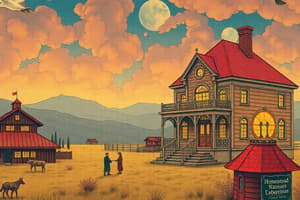Podcast
Questions and Answers
Define the Dawes Act.
Define the Dawes Act.
Attempt to Americanize the Indians.
Give the two reasons why the Great Plains were settled quickly.
Give the two reasons why the Great Plains were settled quickly.
- Cheap land (correct)
- Gold (correct)
- Railroads (correct)
- Manifest destiny (correct)
Define the Morrill Act.
Define the Morrill Act.
Government going to give money and land to states to build colleges.
What were three problems farmers experienced in the late 1800s?
What were three problems farmers experienced in the late 1800s?
Define the Chisholm Trail.
Define the Chisholm Trail.
Describe the Federal Government's policy toward the Native Americans in 1834.
Describe the Federal Government's policy toward the Native Americans in 1834.
What motivated people to settle in the Black Hills?
What motivated people to settle in the Black Hills?
Define a 'soddy.'
Define a 'soddy.'
Define a special interest group.
Define a special interest group.
What did the Grange want?
What did the Grange want?
Define sectionalism.
Define sectionalism.
Describe the role of women on the Great Plains.
Describe the role of women on the Great Plains.
What was the number of buffalo in the year of 2000?
What was the number of buffalo in the year of 2000?
Define a 'buckaroo.'
Define a 'buckaroo.'
What year did they pass the Dawes Act?
What year did they pass the Dawes Act?
What were things they tried to make the Native Americans do during the Dawes Act?
What were things they tried to make the Native Americans do during the Dawes Act?
What is a cattle drive?
What is a cattle drive?
Why did people settle in the Great Plains so quickly?
Why did people settle in the Great Plains so quickly?
Define the 'Homestead Act.'
Define the 'Homestead Act.'
What was it like to live on the Plains?
What was it like to live on the Plains?
What were the advantages of a soddy?
What were the advantages of a soddy?
What was the main invention that was good?
What was the main invention that was good?
What did the South and West economies revolve around?
What did the South and West economies revolve around?
What did the North and East revolve around?
What did the North and East revolve around?
Who ran during the presidential election of 1896?
Who ran during the presidential election of 1896?
What was the campaign issue of 1896?
What was the campaign issue of 1896?
Who won the election of 1896?
Who won the election of 1896?
Reasons people went west?
Reasons people went west?
Define the Populist Party.
Define the Populist Party.
Who was the US general?
Who was the US general?
Name two Native American leaders.
Name two Native American leaders.
Flashcards are hidden until you start studying
Study Notes
Native American Relations and Policies
- Dawes Act (1887): Aimed to Americanize Native Americans by allotting them individual plots of land and encouraging assimilation into American culture.
- 1834 Government Policy: Designated the Great Plains as Native American territory, reflecting the early recognition of indigenous land rights.
Settling the Great Plains
- Rapid settlement driven by railroads for transportation, cheap land, gold discovery, and the ideology of manifest destiny.
- Black Hills settlement motivated primarily by the discovery of gold.
- Homestead Act: Offered 160 acres of land for free to settlers willing to cultivate it, promoting westward expansion.
Challenges Faced by Farmers
- Late 1800s Farmer Issues: Farmers encountered land scarcity, high railroad freight charges, and declining crop prices, leading to economic difficulties.
- Life on the Plains: Harsh climate conditions, limited medical care, and inadequate protection contributed to a challenging living environment.
Infrastructure and Economy
- Cattle Drives: Involved moving cattle to rail lines for shipment to markets, crucial for the meat industry.
- Economies: Southern and Western economies primarily revolved around agriculture, while the Northern and Eastern regions were focused on industry.
Roles and Innovations
- Women's Roles: Women on the Great Plains often worked in farming and shared similar responsibilities as men.
- Soddy Housing: Built from dirt, these homes were warm in winter and cool in summer, serving as practical accommodation.
- Steel Plow: Created by John Deere, this innovation greatly improved farming efficiency on the tough Prairie soil.
Political Context
- Populist Party: Advocated for the interests of farmers and addressed their concerns during the economic struggles of the late 19th century.
- 1896 Presidential Election: Featured candidates William McKinley (Republican) and William Jennings Bryan (Democrat), with a significant focus on monetary supply issues.
Native American Leaders
- Notable figures include Crazy Horse and Sitting Bull, who played key roles in resisting U.S. policies affecting Native American lands and culture.
Social Groups and Terms
- Special Interest Groups: Organizations like the Grange aimed to influence legislation in favor of farmers' interests.
- Sectionalism: The phenomenon where loyalty to one's region outweighs allegiance to the entire country, affecting national unity.
Fun Fact
- As of the year 2000, there were approximately 260,000 buffalo, highlighting the ongoing efforts to conserve this iconic species.
Studying That Suits You
Use AI to generate personalized quizzes and flashcards to suit your learning preferences.




